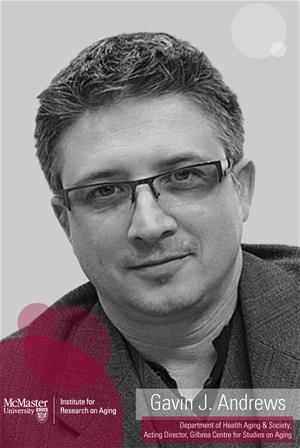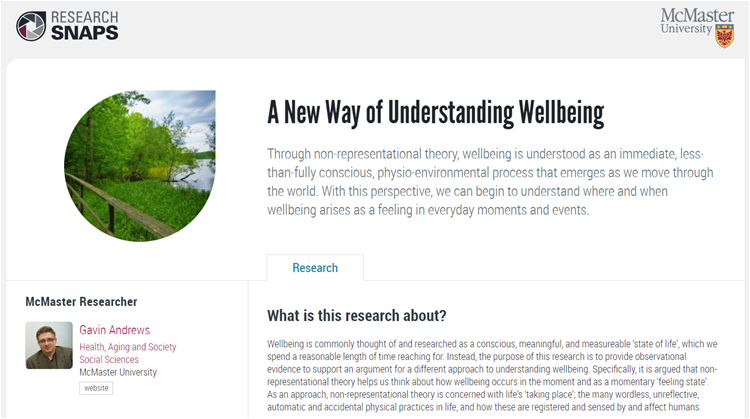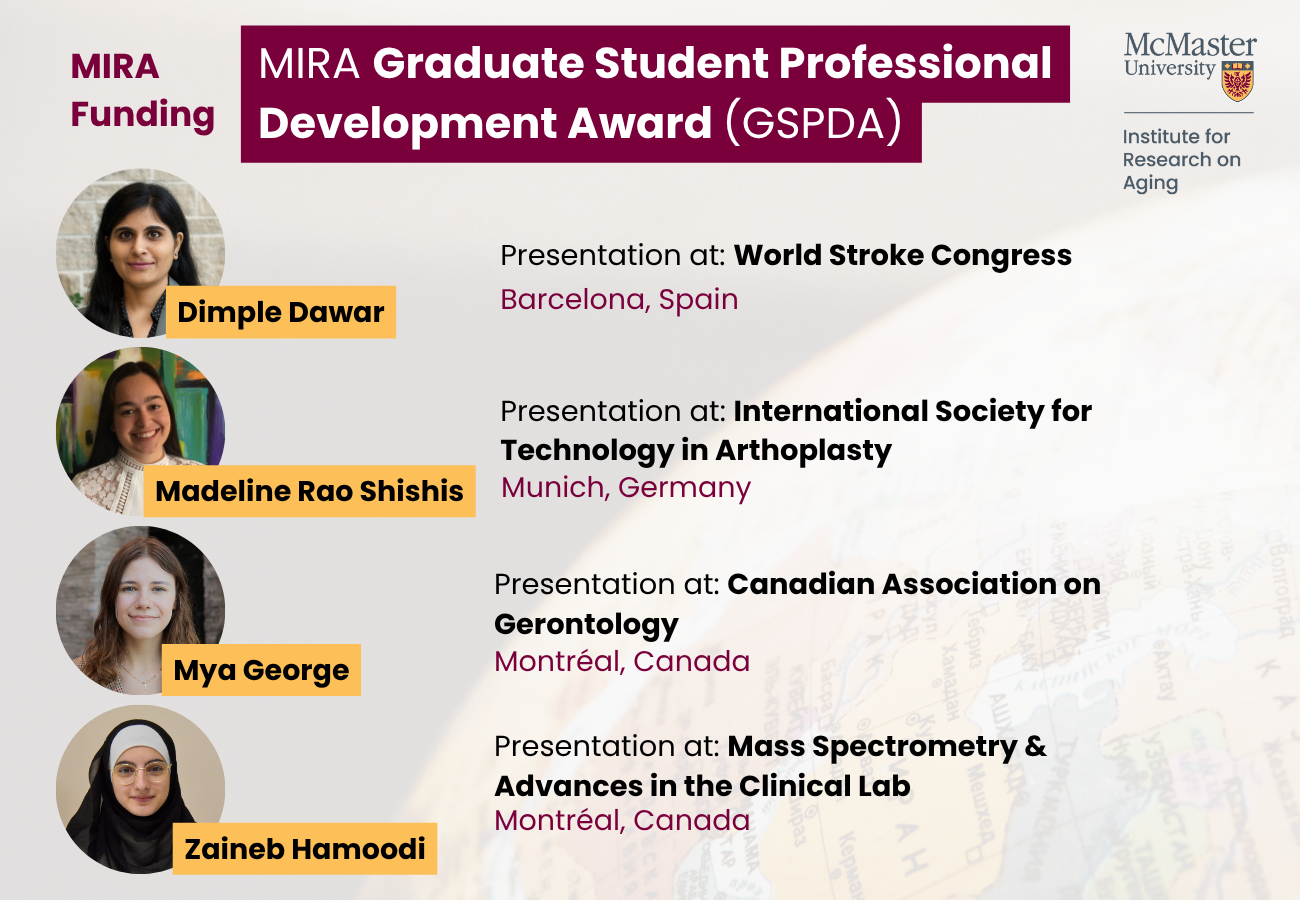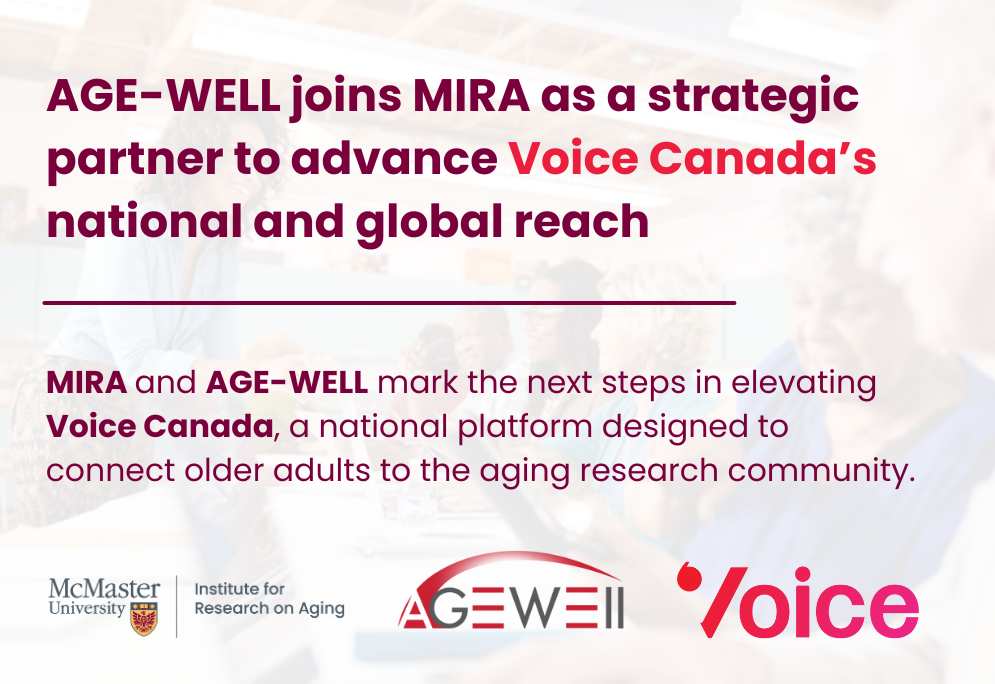 Gavin Andrews is a leading health geographer based at McMaster University’s Department of Health, Aging and Society. He was the inaugural chair of that unit between 2006 and 2011 and the Acting Director of the Gilbrea Centre for Studies in Aging from 2017 to 2018. Gavin’s multidisciplinary research explores a wide range of empirical themes including aging, health care work, sports and fitness, complementary medicine, health histories and popular music. Gavin asks important questions about the relationships between older people and place, and about the current state and future development of health geography. He recently co-edited a book, “Geographical Gerontology”, that highlights the importance of where aging occurs, and how it is experienced differently by different people in different places. He has been a MIRA member since January 2017.
Gavin Andrews is a leading health geographer based at McMaster University’s Department of Health, Aging and Society. He was the inaugural chair of that unit between 2006 and 2011 and the Acting Director of the Gilbrea Centre for Studies in Aging from 2017 to 2018. Gavin’s multidisciplinary research explores a wide range of empirical themes including aging, health care work, sports and fitness, complementary medicine, health histories and popular music. Gavin asks important questions about the relationships between older people and place, and about the current state and future development of health geography. He recently co-edited a book, “Geographical Gerontology”, that highlights the importance of where aging occurs, and how it is experienced differently by different people in different places. He has been a MIRA member since January 2017.
Can you tell us about your research as it relates to aging?
I am a geographer, so my particular brand of gerontology could be referred to as geographical gerontology or the geography of aging. My research has a conceptual emphasis on space and place. So, space could mean the distribution of older populations or services for older people. Place, as geographers see it, is a social and cultural phenomenon that can be felt and lived. For example, place could be particular settings, such as residential accommodations, or it could be age-friendly cities.
How can your research be applied to older adults in the real world?
My research has a lot of real world applications at all scales. When you consider how older populations are distributed around the globe, within countries and then regions, that has huge implications for planning. It has implications in terms of the design of cities, the services required and the accommodation needed to ensure older adults are adequately cared for. On a microscale, the geographical imagination helps inform the architectural design of settings, such as residential homes or the retrofitting of home environments.
Where do you plan to take your research in aging?
I’m interested in non-representational theory. This approach attempts to escape the tendency of social scientists to dig deeper for meanings. Instead, it looks at the active world – what is immediately taking place in space and time. It shows how material, sensory and affective processes combine with conscious thought to make up everyday life. In aging, for example, so many settings are engineered, often by commercial or state interests, to provide specific sensory experiences. Is there something about the sensory design of a nursing home or hospital ward (e.g. lighting, sound, smells) that could be altered to improve the experience for older adults? I’ve just written a book on all of this, called “Non-Representational Theory and Health: The Health in Life in Space-Time Revealing”, which shows how non-representational events are key to human happiness and wellbeing, to the experience of health and disease, to the activities that add to or detract from health and to health care work, as well as the broader initiatives of health institutions.
“There is a lot of diversity within Social Science when applied to aging. Geography is my lens; but you can be an economist, a sociologist, a political scientist, an anthropologist or a social worker studying aging.”​
Can you break down some of the synergies between social sciences and aging?
Social scientists are well-placed to investigate people’s experiences, identities, performances and opinions associated with aging. More broadly, they can capture the social and cultural dimensions of aging, for example whether and in what ways cultures are inclusive or exclusive of older people. There is a lot of diversity within Social Science when applied to aging, just as there is in Health Science. Geography is my lens; but you can be an economist, a sociologist a political scientist, an anthropologist, or a social worker studying aging.
What inspired you to focus your work on aging research?
My original motivation for studying older adults had to do with my upbringing, my family and my home environment. When I grew up, my mom owned a retirement home in the United Kingdom. That business was only a quarter of a mile down the street from our home, so I’d visit often. I was also interested in geography, and there was no question my trajectory would lead me to do a degree in geography, then eventually an aging focused PhD.
What do you find most rewarding about aging research?
It’s always rewarding when people from the community get involved. We have senior class assistants who help teach our students at the department level, and every year we host luncheons to say thank you. I’ve gotten to know these people very well. More generally, it’s always rewarding when a big project is finished and we can produce a key paper or launch a book.
“MIRA provides me with the opportunity to broaden my horizons and work with colleagues — often from sciences and health sciences — who I would not otherwise work with.”​
How did you end up at McMaster University?
When I was Reader in Health Studies at Buckinghamshire University in 2000, I attended a conference in Montreal. It was the first time I had ever been in Canada, and I was impressed by the cities, people and academics. From that point, I started applying for jobs here. My first job in Canada was at the University of Toronto in the Faculty of Nursing where I was an Associate Professor. Then an opportunity arose to become chair of a new department of Health, Aging and Society at McMaster University, so I applied for it. Although I liked U of T and I was successful there, when the opportunity arises to go somewhere like Mac and be an inaugural chair in a new academic department, you don’t say no. It was exactly aligned with my interests. Today, the Department of Health, Aging and Society offers undergraduate degrees in Health and Society and Aging and Society, a Master’s degree in Health and Aging and PhDs in Social Gerontology and Aging and Society. I like to think that I played a good part in developing the graduate program in particular.
What’s the best thing about working at McMaster?
I love McMaster for loads of reasons. We have an excellent international reputation for health and aging research, we encourage and respect critical and radical thinking and we give our researchers the space and time to work on what they want, often at the cutting edge of their fields. So, many of our units have friendly, functional cultures. My department, for example, now chaired by Jim Dunn, is full of very talented people who don’t compete, but respect and support each other. That makes coming to work in the morning very easy.
Why are you a member of MIRA?
I have been at McMaster for twelve years, both in the Department of Health, Aging and Society and the Gilbrea Centre for Studies on Aging. I was able to watch the development and launch of MIRA from a front row seat. MIRA provides me with the opportunity to broaden my horizons and work with colleagues – often from sciences and health sciences – who I would not otherwise work with. I fully recognize that my brand of theoretical work might not suit every project or opportunity, but MIRA is understanding of this.


